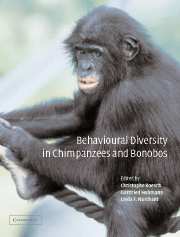Book contents
- Frontmatter
- Contents
- List of contributors
- Preface
- Behavioural Diversity in Pan
- PART I BEHAVIOURAL FLEXIBILITY
- PART II SOCIAL RELATIONS
- PART III FEMALE STRATEGIES
- INTRODUCTION
- 11 Why female bonobos have a lower copulation rate during estrus than chimpanzees
- 12 Social relationships between cycling females and adult males in Mahale chimpanzees
- 13 Seasonal aspects of reproduction and sexual behavior in two chimpanzee populations: a comparison of Gombe (Tanzania) and Budongo (Uganda)
- 14 Costs and benefits of grouping for female chimpanzees at Gombe
- 15 The cost of sexual attraction: is there a trade-off in female Pan between sex appeal and received coercion?
- PART IV HUNTING AND FOOD SHARING
- PART V GENETIC DIVERSITY
- Index
15 - The cost of sexual attraction: is there a trade-off in female Pan between sex appeal and received coercion?
Published online by Cambridge University Press: 08 February 2010
- Frontmatter
- Contents
- List of contributors
- Preface
- Behavioural Diversity in Pan
- PART I BEHAVIOURAL FLEXIBILITY
- PART II SOCIAL RELATIONS
- PART III FEMALE STRATEGIES
- INTRODUCTION
- 11 Why female bonobos have a lower copulation rate during estrus than chimpanzees
- 12 Social relationships between cycling females and adult males in Mahale chimpanzees
- 13 Seasonal aspects of reproduction and sexual behavior in two chimpanzee populations: a comparison of Gombe (Tanzania) and Budongo (Uganda)
- 14 Costs and benefits of grouping for female chimpanzees at Gombe
- 15 The cost of sexual attraction: is there a trade-off in female Pan between sex appeal and received coercion?
- PART IV HUNTING AND FOOD SHARING
- PART V GENETIC DIVERSITY
- Index
Summary
INTRODUCTION
Chimpanzees and bonobos are generally similar in their adult heterosexual behavior. In both species, copulations are largely restricted to females with maximally tumescent swellings (Furuichi 1987; Wallis 1992; Takahata et al. 1996). ‘Group mating’ is the predominant pattern. Rates of copulation vary, but there tend to be several hundred copulations per conception (Goodall 1986; Kano 1992). Furthermore, in both species the relationship between male rank and copulation rate varies in similar ways depending on group composition. Sometimes there is no relationship between a male's dominance rank and his copulation rate (e.g. Gombe chimpanzees: Tutin 1979; Mahale chimpanzees (1980–82,1991): Hasegawa & Hiraiwa-Hasegawa 1990; Nishida 1997; Taï chimpanzees: Boesch & Boesch-Achermann 2000; Wamba bonobos, E1 and E2 1986, P 1988: Takahata et al. 1996). However when a community or party contains few adult males in a stable hierarchy, higher-ranking adult males can achieve more copulations than lower-ranking males (Gombe chimpanzees in 1973–74: Goodall 1986; Mahale chimpanzees in 1992, Nishida 1997; Wamba E-group bonobos 1979: Kano 1996; Lomako bonobos: Gerloff et al. 1999). Dominant males then gain their advantage partly by interfering, at least occasionally, with subordinates' copulations (e.g. in 7% of bonobo copulations, Kano 1992).
Despite such similarities, heterosexual activity also varies in significant ways. A prominent example is the number of sexual cycles per conception, which ranges from an average of 3.6 for Gombe mothers to an average of 29.2 for Taï mothers. Such differences in sexual cycling have no relation to reproductive rates since the population interbirth intervals are similar in different sites (Takahata et al. 1996; Boesch and Boesch-Achermann 2000; Knott 2001).
- Type
- Chapter
- Information
- Behavioural Diversity in Chimpanzees and Bonobos , pp. 204 - 216Publisher: Cambridge University PressPrint publication year: 2002
- 64
- Cited by

